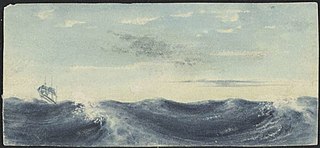Neva was a three-masted barque launched in 1813. She made two voyages transporting convicts to Australia. On her second voyage carrying convicts she wrecked in Bass Strait on 13 May 1835. Her loss was one of the worst shipwrecks in Australian history; 224 lives were lost.

HMS Buffalo was a storeship of the Royal Navy, originally built and launched at Sulkea, opposite Calcutta, in 1813 as the merchant vessel Hindostan. The Admiralty purchased her that year after she arrived in Britain. She later transported convicts and immigrants to Australia, before being wrecked in 1840.
Richard Brooks (c.1765–1833), pioneer New South Wales settler, was born in Devon, England, the son of Henry Brooks, a clergyman of Salcombe Regis and Honoria Hall.
John Barry was a three-masted merchant ship, convict transport, and immigrant transport built in 1814 at Whitby, England by John Barry for his own interests. A typhoon damaged her in 1841 and at last report she was an opium hulk at Hong Kong.
Admiral Gambier was launched on 24 September 1807 for J. W. Buckle & Company. She made two trips to Australia as a convict transport and one trip from China to Britain for the British East India Company (EIC) before she was wrecked in 1817.
Roslin Castle was a barque of 450 tons built in 1819 at Bristol. She was a merchant ship that also made five voyages transporting convicts to Australia. Described as a single decker, her hull was sheathed in copper in 1823 and was sheathed in patent felt and copper over-boards in 1828. She later served as a whaling vessel out of Sydney, Australia.
Asia was a merchant ship built by A. Hall & Company at Aberdeen in 1818. She made eight voyages between 1820 and 1836 transporting convicts from Britain to Australia. She made one voyage for the British East India Company (EIC) between 1826 and 1827. At the same time she served in private trade to India as a licensed ship. She also carried assisted emigrants to Australia. She was last listed in 1845.
Caledonia was a merchant ship built in British India in 1829. She traded between India, China, Mauritius, and the Australian Colonies. She played an important role in the development of King George Sound. She made two voyages transporting convicts, one voyage from Madras and the other from Swan River Colony, both to Sydney, Australia. After her sale in 1840 her registry shifted to London and she became a general trader. She was last listed in 1855.
Camden was a merchant ship built upon the River Thames in 1799 as a West Indiaman. Between 1832 and 1833 she made two voyages transporting convicts from England to Australia. She was wrecked in 1836.

Waterloo was a merchant ship built at Bristol, England in 1815. On her first voyage she suffered a short-lived mutiny. She then made one voyage under charter to the British East India Company (EIC). She made four voyages transporting convicts from England to Australia, and two voyages from Ireland to Australia. On her seventh convict voyage Waterloo wrecked on 28 August 1842 in Table Bay with great loss of life.
Royal Admiral was a 414-ton timber three-masted barque, built at King's Lynn, England in 1828 and used as a merchant ship. Royal Admiral first served for trade to India. She subsequently sailed to Australia on four occasions carrying convicts, from Portsmouth to Port Jackson in 1830, from Dublin to Port Jackson in 1833 and 1834, and from Woolwich to Hobart Town in 1842.
Countess of Harcourt was a two-decker, teak merchant ship launched at Prince of Wales's Island in 1811, and sold in Great Britain in 1814. An American privateer captured her in 1814, but the British recaptured her in 1815. Later, she made five trips transporting convicts to Australia. Between the third and fourth of these, she undertook a voyage to China and Nova Scotia while under charter to the British East India Company (EIC). She was wrecked in late 1830.
Elizabeth was a merchant ship built at Singapore, British India in 1830. She made one voyage transporting convicts from the Swan River Colony to Sydney, Australia. She wrecked in 1839.
Gaillardon was a merchant ship built in Calcutta, British India in 1833. She made three voyages transporting convicts from India to Australia and was wrecked upon the Coromandel Coast in 1840.
Integrity was a 220-ton merchant ship built at Redbridge, Southampton, England in 1824. She made two voyages transporting convicts from Mauritius to Australia. She was wrecked in the Torres Strait in August 1841.
Isabella was a 179-ton merchant ship built in Redbridge, England, in 1823. She made one voyage transporting convicts from Mauritius to Australia.
Henry Wellesley was a 304-ton barque sailing ship built in 1804 by Bacon, Harvey & Company at Calcutta, British India. She was wrecked near Calais in 1841.
York was a sailing ship built in 1819 at Southwick. She made one voyage to Bombay for the British East India Company (EIC) in 1820. She made three voyages transporting convicts to Australia between 1829 and 1832. She was condemned and sold for breaking up in 1833 at Mauritius.
Several vessels have borne the name Dart, for the dart or the River Dart:

Africaine, was a barque launched in 1831 at Jarrow on the River Tyne in England. In 1836 she carried immigrants as part of the First Fleet of South Australia. She was wrecked on 23 September 1843.


